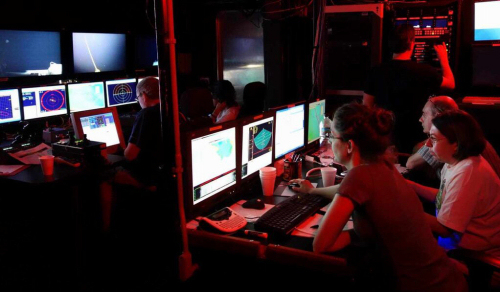Thursday 7th February
Thanks to the speed boost from a following current, we had time overnight to divert slightly in the approach to our first target site. This allowed us to use the ship's sonar to fill in a gap in the map that we made in April 2010 of the seafloor of the area; a nice to start our expedition with a bonus of opportunistic data.
At 0645h local time, just as dawn broke, we arrived over Mount Dent, an underwater mountain twice the height of Ben Nevis - the highest peak in Britain - but whose summit still lies 2.3 km beneath the waves.
(Mount Dent: 3D map by Tim Le Bas, from RRS James Cook Voyage 44 data)
Beneath us, on the upper slopes of Mount Dent, is the Von Damm Vent Field, where hot fluids gush from a pyramid-like structure of mineral deposits on the seafloor. Those deep-sea vents will be the target of our attention for the next few days.
Our first task on arriving above the Von Damm Vent Field was to lower a sensor called a CTD probe almost to the seabed, to measure the temperature and salinity of all the layers of water beneath the ship. Those data then allow us to calibrate the acoustic navigation system that we use to track the Isis ROV. The chemistry team also took advantage of the CTD deployment to collect water samples for analysis, to see how the hot fluids from the Von Damm Vent Field disperse into the ocean above, and the impact that they have on its chemistry.
Once the CTD deployment was complete, and the data programmed into the acoustic navigation system, it was time to launch the Isis ROV. Isis dive #197 went into the clear blue Caribbean water at 1115h local time, and two hours later reached the seafloor 2.3 km below.
The first Isis dive at this site will spend more than 24 hours flying 25 metres above the seafloor in a series of parallel lines - a pattern known as "mowing the lawn" - to map the area in very fine detail with a sonar system. This map will allow us to plan our further operations, and aid the geology team in their interpretations of what drives the vents here. The cycle of six-hour science watches in the ROV control centre has begun, and it feels good to be back in that dimly red-lit den, watching the video and data screens as we work again on the seafloor.

(Photo: Will Homoky)
